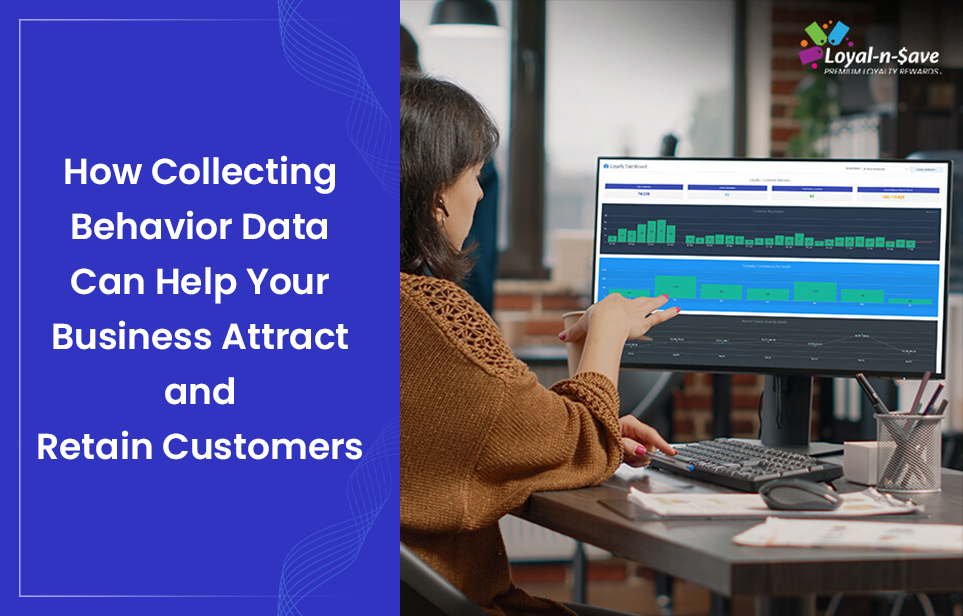How Collecting Behavior Data Can Help Your Business Attract and Retain Customers

You’ve worked hard to become a business owner. You’ve dotted your i’s and crossed your t’s—or so you think. But your intuition is saying that you’re not reaching your full potential. You’re submerged in a pool of competitors, and you want to stand out from the crowd. Your business is so unique in its own way, and you want others to see that. However, the idea of growing your business seems so far out of reach.
You are out of ideas for enhancing your marketing tactics and capturing customers’ souls, but that’s alright! All you need is a fresher, more modern, and more successful strategy. Customer behavior analytics are useful in this situation. What is it, then? Consider it an opportunity to pick your customers’ brains and learn what’s on their minds, which you then respond to.
One of the primary reasons why businesses will collapse within the next ten years, according to Forbes’ Bernard Marr, is because they do not prioritize their customers. Marr argues, “Everything a company offers must provide value to customers and make their lives better and easier.” He continues, “Putting customers first also means not being afraid of letting go of existing products and services and getting rid of anything that doesn’t add value to customers.”
Humans aren’t just statistics in a report, after all. Transactional KPIs cannot capture what customers want. The needs of your customers cannot be reflected in transactional KPIs. As a business owner, it’s your responsibility to understand the motivations and thought processes of your customers that go into these purchasing choices. To do this, you undertake a detailed analysis of your customers and use the results to increase sales and boost customer lifetime value.
Today, we will learn about the customer behavior analytics approach and how to use it. Customer behavior analysis and the use of behavioral data in the long run can result in more effective customer acquisition, enhanced customer experiences, and greater customer retention.
Let’s discuss customer behavior analysis
So, let’s go through the basics. Customer behavior analysis is the study of how customers choose between a product, service, and/or company. The outcomes of a behavior study give you the knowledge you require about the ideal customer profile and enable you to develop successful eCommerce business strategies. Customer behavior analysis enables you to stay ahead of the eCommerce curve in a market where customers have countless options and possibilities.
Customer behavior research should go beyond tracking monthly active users, examining shopping activity, or only examining the demographic information you can gather about your customers (like age, location, gender, etc.). It’s crucial to do a more thorough analysis and determine the answers to the following crucial questions: why did customers initially pick me, what motivates them to return, and why do they churn.
The customer’s voice is everything. The first step to establishing and remaining relevant in today’s fiercely competitive climate and frequently oversaturated market is to listen to it. You must have a basic understanding of the three factors that influence customer behavior before starting your analysis. These elements are beyond your control, but you can take them into consideration when creating particular customer journeys and behavioral segmentation.
A shopper’s personality
Your customer base is made up of many individuals, each of whom is as multifaceted as they come. Some individuals will be irritable and impatient, while others will be courteous and calm. Some people will fall halfway between the two extremes or show completely distinct personality traits. You can learn what kinds of individuals you attract and how to deal with them as a business by examining how customers interact with your brand and routinely collecting input.
Psychological triggers and responses
Even though your goods and services cater to the same need, customers express it in different ways. You can foster long-term customer relationships that are profitable and relevant by getting to know your customers and what motivates them.
Trends in society
Since people are highly social, they have an inescapable need to blend in and be a member of a group. Every community, whether it be one that involves baking, sports, or other activities, has its own customs and practices. Consider external elements such as peer pressure, recommendations, norms, or cultural trends when determining whether a buyer will buy from you or not. You must keep up with trends and be ready to adapt your marketing strategies accordingly.
In the social media-enhanced digital age, it can be challenging to resist feeling influenced by prominent personalities or celebrities who we look up to and aspire to be like. Consider Hailey Bieber, who in 2022 debuted her “glazed donut” nails in the digital realm. This style quickly became popular on social media. An excellent example would be a nail salon attempting to advertise its selection of nail polishes by uploading a video of a nail technician giving a tutorial on how to achieve the Hailey Bieber look so that their customers can try it out for themselves.
We can examine the necessary procedures for a customer behavior analysis now that we are aware of the factors influencing customer behavior.
Customer behavior analysis steps
1. Divide your audience into groups
The goal is to identify the main demographic groups that visit your website and/or buy your products and have a thorough grasp of the distinctions within these groups. The demographics in your customer database and marketing funnel should be examined first. Even the most basic information from Google Analytics can serve as a starting point. What areas do your users hail from? What is their age? What types of devices are they using to visit your website?
You shouldn’t limit your research to web analytics. Look further: What are their backgrounds in the workplace? Which media do they enjoy? Where do they shop elsewhere? What social networks do they utilize? What led them to you? How quickly did they buy from you after learning about your business or product?
You can get some of these answers with the use of customer behavior analytics technologies, but qualitative research techniques like user surveys and interviews are much more helpful in this situation. When considering segmentation, keep in mind that your most valuable customers are probably the most significant group, so it can be a fantastic approach to identify them first and work backwards from there. Who are your most valuable customers, and what characteristics do they share? Your greatest customers can be found using metrics like customer lifetime value, average purchase value, frequency rate, etc.
That being said, don’t completely disregard other sections. A more valuable group of customers could be visiting your website but not making a purchase because you aren’t emphasizing the correct selling point for them. In other words, you can be missing out on customers because of your customer acquisition, marketing, or product strategies. This leads us to the next action:
2. Determine the groups’ selling points
After determining your most significant customer segments, you must comprehend their purchasing motivations. What motivated that choice? Because the answers to these questions might not be in your analytics, qualitative research methods like user interviews are crucial in this situation. You require measurable user behavior data. Furthermore, you want to know as much as you can about the reasons and processes behind each customer’s choices, and the only way to do that is to speak with them. For instance, did they need your goods immediately to solve an issue, or was it more of an impulse buy? Did they research or take competitors into account? What did they think of the price?
3. Gather as much information as you can
Getting qualitative customer insights was the focus of the previous step, but once you’ve done that, it’s time to incorporate as much quantitative data as you can. Data analytics abilities are useful in this situation. Ideally, you already have some of these skills as a marketer, but data analysts and analytics platforms and technologies can also be useful in this situation.
What information? Obtain everything that is available. That data, along with any other information you may have on individual or collective customer behavior, will be extremely pertinent if you have conducted any cohort analysis or customer journey analytics. It will be essential to use whatever behavioral analytics data you may have. Data from both sponsored and organic channels should be included in the collection of all marketing analytics data.
However, you shouldn’t confine yourself to only information that’s centered around the business. Look up any industry data that is accessible and get as much information as you can about your competition. You will have a solid base from which to perform your analysis if you have industry/market data, quantitative business data, and qualitative individual data points.
4. Compare the numbers to your qualitative information
As soon as you have all of your data, you should begin the actual customer behavior analytics. Analyze the quantitative data for patterns and insightful information, then compare it to your qualitative data and customer journey map. Comparing these things will probably show some obvious areas that need attention right away.
But if you’re having trouble, these questions are an excellent place to start:
Which of your user groups is making purchases from you? What are loyal customers? What marketing strategies are effective for particular market segments?
Are these responses consistent with what you’ve observed in industry data or with what customers have told you in surveys and interviews?
5. Make the necessary modifications
The following step is to test the adjustments and optimizations suggested by the findings of your analysis in step four. You should immediately incorporate what you’ve learned into your marketing strategy. Consider the scenario when you identify a group of customers who are incredibly loyal, share certain demographic characteristics, visit your website through independent review sites, and use Facebook frequently. Using this knowledge, you might produce a Facebook branding campaign targeted at their audience that highlights their strongest selling point (your superior reviews on third-party sites). Additionally, you could improve the marketing copy on the most frequently visited sites by these customers.
But that’s just a basic instance. Your research could point you in a more complex direction, such as using predictive analysis to target specific user groups at specific times and present them with the most applicable content, advertisements, and products.
6. Analyze the outcomes, then do it again
Any customer behavior analysis must end with more analysis. This should not be viewed as a one-time activity, but rather as an ongoing optimization process that informs each marketing campaign. This is because customers and the market will evolve even if your product doesn’t.
However, customer behavior is influenced by a variety of factors, including societal trends, competition marketing, economic forces, and a host of other factors. Analyzing customer buying behavior today will reveal excellent optimizations for you to execute right away. Maintaining constant contact through continued customer behavior analytics in both qualitative and quantitative forms is the best way to ensure that you fully understand your customers and the shoppers in your market.
The value of studying customer behavior
Buyers currently have hundreds, if not more, options to pick from, whether they want to meet their needs, satisfy a desire, or advance their lives. Therefore, you must comprehend customer behavior and create pertinent acquisition efforts if you want to win their hearts and their wallets. Because of the intense competition, rising expenses, and growing number of customers who choose not to have their cookies monitored, it’s important to go back to the beginning and make smart use of your customer data.
Customer behavior analytics also gives you the ability to pre-qualify leads even before they are acquired, which is another advantage. You can accept that not everyone will be a fit for your products or services. Filtering your audience won’t do you any harm. Analyzing customer behavior enables you to find customers with profitable lifetime potential rather than aiming to please everyone and win over as many new customers as you can.
Every eCommerce company wants such customers—the ones who buy frequently, spend a lot of money with you, and tell their friends about you. These customers don’t just show up. The acquisition and retention efforts are the result of intricate, data-driven choices. Marketers and sales teams must examine customer data and behavior before making these choices.
The following are some things that customer behavior analysis can assist you with, if done correctly:
Determine common issues (or chances to improve)
Data about your customers has inconsistencies, according to quantitative research. You will see trends if you examine these inconsistencies:
- Customers that leave a specific store are leaving from that location
- After ordering a certain product, customers began to defect
- After a given number of interactions, customers start to leave
By combining it with qualitative research and performing customer interviews, you can learn about common problems that can be resolved.
For instance, if sales are declining in a certain area, your delivery services could be flawed—products may be delivered late, damaged, or not at all. With this knowledge, you can change your delivery methods and enhance customer retention there. The same logic holds true for decreasing customer churn. If you identify the frequent causes of customer churn, you can fully solve the issue.
Alter the marketing techniques
Customers don’t impulsively purchase or switch products. Either they find a better choice or something happens to break their routine. Understanding the advancement your customers seek can help you modify your marketing plan so that it is more appealing and relevant to other prospective customers.
Improve the message—timing and material
You can forecast when a customer will make another purchase using customer information, including buying frequency and recency. As a result, you can schedule your upsell campaigns for just before a customer needs your services once more. Nobody likes to stack goods; they want to make use of them and then leave. Sending the appropriate message to the appropriate customer group at the appropriate time will satisfy this need.
Boost the satisfaction of customers
Every successful eCommerce business has a satisfied customer at its core. Behavioral data is available to help if you feel cut off from your customers and lost in delivering exceptional customer service and experience. However, by knowing how customers interact with and perceive your brand, you can recognize and address any weak spots. In this approach, once word-of-mouth marketing starts spreading, you can reduce turnover and even increase market share.
Raise conversion rates
Information crucial to business, including preferred channels, triggers, and brands, is revealed by customer behavior data. You can avoid pushing unsuitable products on the wrong channels if your marketing decisions are in line with the reality shown by your data. The benefit of using customer data to boost sales is that you can stop depending on intuition or trends. Making wise selections based on your facts allowed you to hit the mark.
Boost customer lifetime value (CLV)
The eCommerce industry’s game-changer is CLV. Businesses are gradually realizing that they can no longer rely just on traffic and acquisition. Customers have a variety of purchasing behaviors, and they anticipate that you will respond to them immediately. It is your obligation to use customer journey mapping to satisfy these needs. You must examine your data to determine your customers’ purchasing trends. Create a distinct customer journey for each segment after segmenting all customers into several customer bases. Customer behavior analysis sits squarely in the middle of the three primary pillars of CLV: meeting customer demands, resolving issues, and giving high-value customers top priority.
Conclusion
Recognizing different customer types has always been crucial. Today, however, it’s crucial to understand your customers. Consider the following questions for yourself: What prompts people to purchase your goods? What do they expect to gain from your services? What do they anticipate from you?
It is important to live up to the expectations of your customers. Instead of pretending to be customer-centric in order to increase sales, you should align your entire business with the lifecycle marketing stage, have all of your departments focus on the customer experience, and put the customer first. Never forget that value is the key to winning. They gain the market share, the devoted customers, and the steady, predictable growth that many eCommerce businesses long for.
Looking to attract and retain customers at your business but don’t know where to begin? Loyal-n-Save has got your back! To get started, get in touch with one of our specialists today to set up a consultation and demo.
This article was written by Loyal-n-Save, an omni-channel customer loyalty solution for retailers looking to increase customer retention and new customer acquisition.
Posted on Jan 2, 2023









